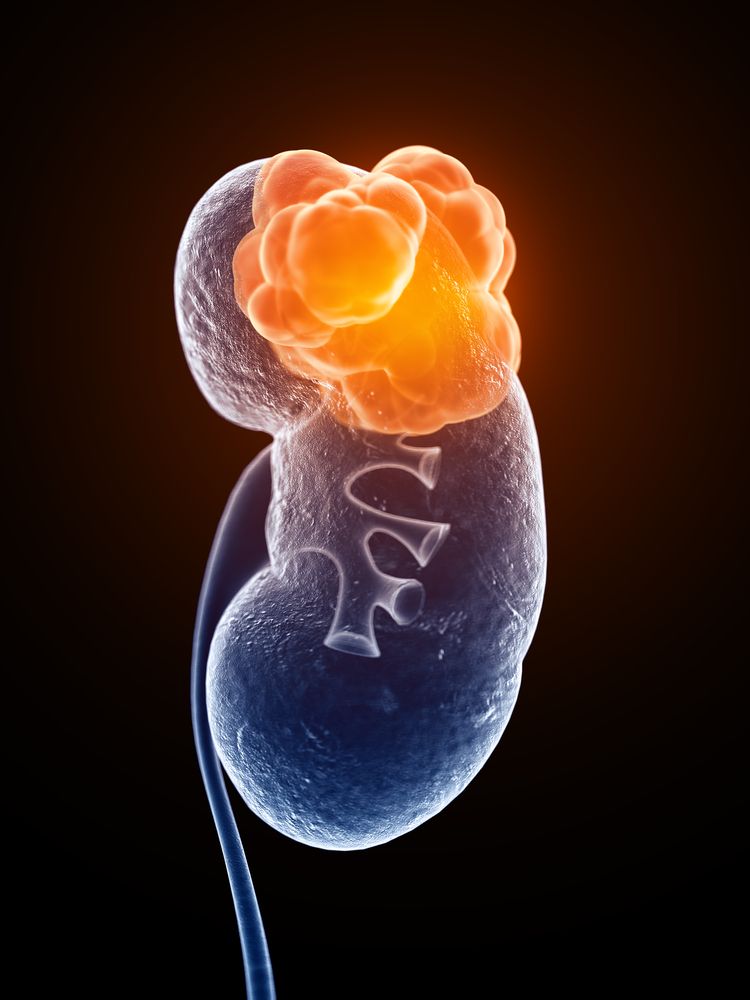Cabozantinib Triplet Therapy Yields Meaningful Benefit in RCCvh
Patients with renal cell carcinoma with variant histologies appear to benefit from treatment with a triplet regimen of cabozantinib, nivolumab, and ipilimumab.
Treatment with cabozantinib (Cabometyx) plus nivolumab (Opdivo) and ipilimumab (Yervoy) resulted in clinically meaningful efficacy in a population of patients with renal cell carcinoma with variant histologies (RCCvh), according to data presented at the 2023 American Society of Clinical Oncology (ASCO) Annual Meeting.
“Combinations of immunotherapy and tyrosine kinase inhibitors yields response rates near 50% in RCCvh but novel approaches are needed,” according to Bradley A. McGregor, MD, principal investigator of the trial, a senior physician at Dana Farber Cancer Institute, and director of Clinical Research at the Lank Center for Genitourinary Oncology.

Data from a multi-institutional, prospective, single-arm phase 2 trial (NCT04413123) showed that at a median follow-up of 10.4 months, patients (n = 39) experienced an objective response rate of 18% (80% CI, 10%-28%) with a disease control rate of 76%. All responses were partial responses (PRs), with stable disease (SD) was reported in 59% of patients and progressive disease (PD) reported in 23%. The median duration of response was not reached for responders; however, 86% maintained a response for greater than 6 months.
At the time of the analysis, 14 patients remained on therapy, and 25 discontinued due to progressive disease (n = 12), unacceptable toxicity (n = 8), withdrawal (n = 1), other reasons (n = 2), starting nonprotocol therapy (n = 1), and 1 patient died.
When examining histology, those with papillary disease (n = 20) reported a PR rate of 25%, SD rate of 55%, and a PD rate of 20%.Patients with chromophobe disease (n = 11) experienced PR, SD, and PD at rates of 9%, 45%, and 45%, respectively. Further, patients with translocation histology (n = 5) and other (n = 2) all achieved SD, and the 1 patient with unclassified RCC achieved a PR.
Those without sarcomatoid differentiation (n = 30) experienced PR, SD, and PD rates of 17%, 63%, and 20%, respectively. These outcomes were reported at rates of 22%, 44%, and 33%, respectively, among those with sarcomatoid differentiation (n = 9). When analyzed by prior therapy, those who had received prior therapy (n = 5) had no PRs, with 60% of patients achieving SD and 40% having PD. Among those who had not received prior therapy (n = 34), partial responses were achieved in 21% of patients, with 59% and 21% having SD and PD, respectively.
Kaplan Meier estimates of progression-free survival (PFS) rates at 6 and 12 months were 68% (95% CI, 50%-80%) and 51% (95% CI, 32%-67%), respectively. The 12-month overall survival (OS) Kaplan Meier estimate was 79% (95% CI, 58%-90%).
“Combinations of immunotherapy and tyrosine kinase inhibitors yields response rates near 50% in RCCvh but novel approaches are needed,” Bradley A. McGregor, MD, principal investigator of the trial, a senior physician at Dana Farber Cancer Institute, and director of Clinical Research at the Lank Center for Genitourinary Oncology, wrote.
“In COSMIC-313 [NCT03937219], cabozantinib with nivolumab and ipilimumab improved PFS over nivolumab/ipilimumab in clear cell RCC,” investigators wrote, noting that clear cell histology has a better prognosis than RCCvh. However, they added that the COSMIC-313 “survival data remain immature.”
High-dose steroids such as 40 mg or more of prednisone were required in 44% of patients and 21% of patients discontinued therapy because of toxicity. Adverse events occurred at grades 3 and 4 with the most common including increased alanine aminotransferase levels (36%), increased aspartate aminotransferase levels (23%), cardiac effects (10%), decreased platelet counts (5%), hyponatremia (5%), hypertension (5%), increased creatine levels (5%), fatigue (5%), and oral mucositis (5%).
Agents were administered until progression with cabozantinib given continuously at a dose of 40 mg daily with reductions to 20 mg daily and 20 mg every other day allowed. Nivolumab was given at 3 mg/kg and ipilimumab at 1 mg/kg intravenously every 3 weeks for 4 cycles followed by nivolumab 480 mg IV every 4 weeks.
Dose reductions of cabozantinib to 20 mg daily occurred in 72% of patients and reductions to 20 mg every other day occurred in 18% of patients. Patients received 2 or more (34%), 3 (23%), or 4 (44%) cycles of nivolumab and ipilimumab and 24 patients were given nivolumab maintenance with the median number of cycles received being 6 (range, 1-24).
Additionally, patients had a median age of 58 years (range, 37-81), were mostly men (69.2%), had an ECOG score of 0 (84.6%) or 1 (15.4%), and the majority had not received prior systemic therapy (87.2%). Patients were in the IMDC risk groups of favorable (25.6%), intermediate (56.4%), and poor (17.9%). The primary end point of the trial was objective response rate per RECIST 1.1 criteria, and secondary end points included PFS, OS, and safety.
An expansion cohort is currently enrolling with 20 mg cabozantinib, nivolumab, and ipilimumab (NCT0441312).
Disclosures: Dr McGregor has a consulting or advisory role withAstellas Pharma, Bristol-Myers Squibb, Calithera Biosciences, Eisai, EMD Serono, Exelixis, Genentech/Roche, Merck, Pfizer, and Seattle Genetics/Astellas. He receives research funding from Bristol-Myers Squibb, Calithera Biosciences, Exelixis, Pfizer/EMD Serono, and Seattle Genetics/Astellas.
Reference
McGregor BA, Huang J, Xie W, et al. Phase II study of cabozantinib (Cabo) with nivolumab (Nivo) and ipilimumab (Ipi) in advanced renal cell carcinoma with variant histologies (RCCvh). J Clin Oncol. 2023;41(suppl 16):4520. doi:10.1200/JCO.2023.41.16_suppl.4520
Newsletter
Stay up to date on recent advances in the multidisciplinary approach to cancer.